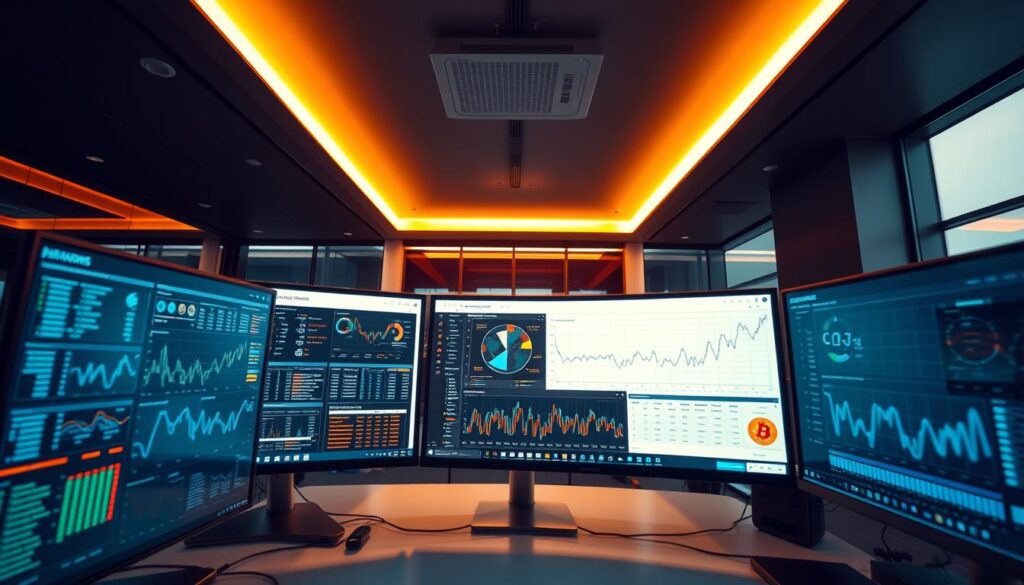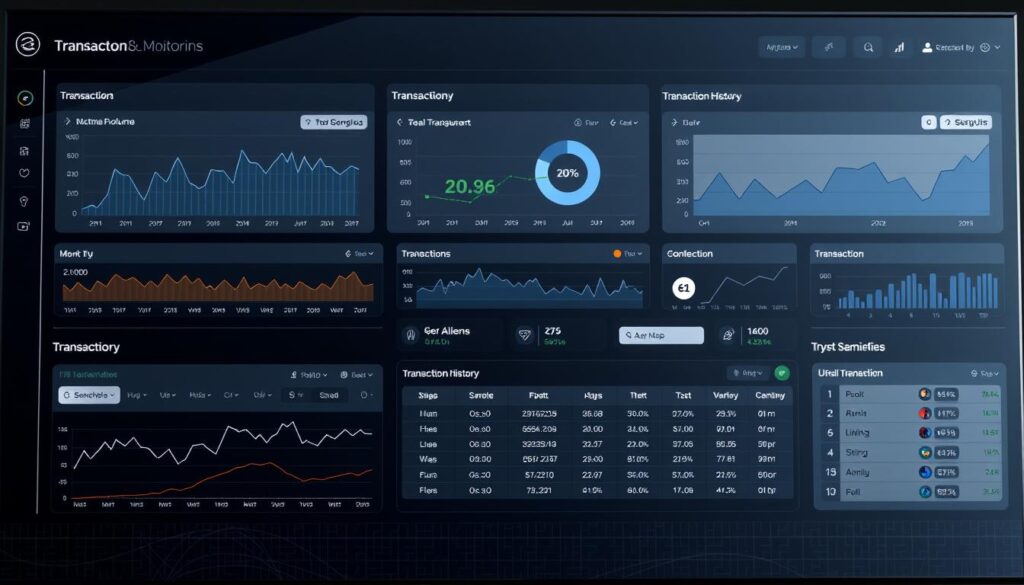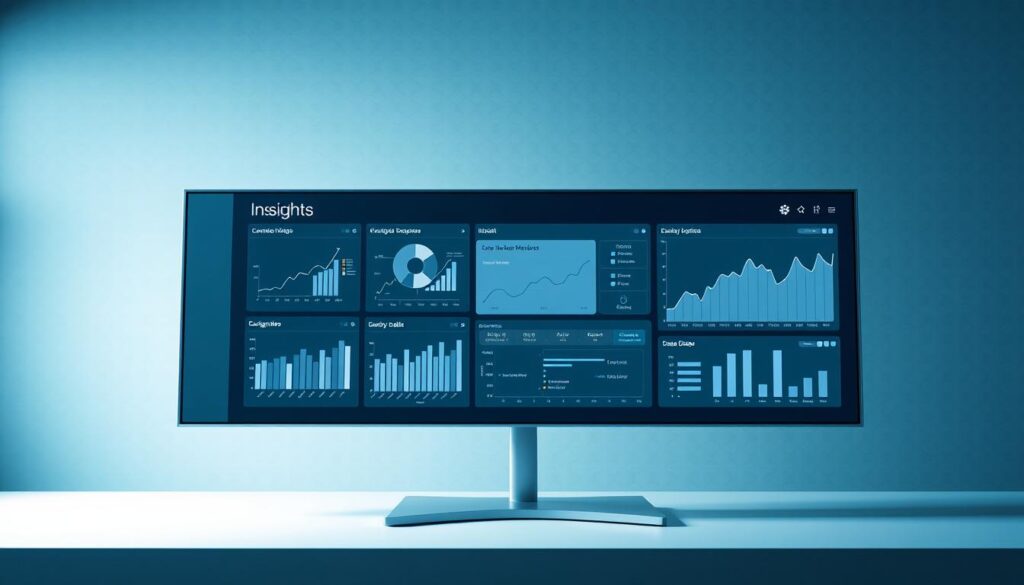Modern enterprises face a critical challenge: understanding complex digital transactions at scale. A recent Coinbase study shows Fortune 500 companies increased their decentralized technology projects by 39% since 2023. This surge highlights the need for tools that simplify interaction with encrypted ledgers.
Specialized platforms now turn intricate transaction patterns into clear business intelligence. These systems help organizations trace activities, evaluate risks, and maintain regulatory standards. Financial institutions and law enforcement alike rely on them to navigate digital asset ecosystems securely.
Cutting-edge solutions merge artificial intelligence with user-friendly dashboards. Real-time processing identifies emerging trends while predictive models forecast risks. This combination empowers teams to act decisively in fast-paced markets.
Key Takeaways
- Major corporations increased blockchain-related projects by 39% in 2024
- Advanced tools convert encrypted transaction records into actionable reports
- AI-powered systems enable real-time risk detection and trend prediction
- Compliance monitoring has become more efficient through automated tracking
- Interactive dashboards simplify complex network interactions for all users
Introduction to Blockchain Analysis and Visualization Tools
Digital networks now process millions of transactions hourly, requiring specialized methods to interpret activity patterns. Sophisticated platforms decode encrypted records, revealing hidden connections between wallets and exchanges. These systems help teams monitor asset transfers while maintaining compliance with evolving regulations.
Understanding the Role of Analytics in the Blockchain Ecosystem
Advanced platforms transform transaction histories into strategic insights. They map relationships between addresses, flagging unusual transfers through AI-driven pattern recognition. Financial institutions use these findings to prevent fraud and validate transaction legitimacy.
| Feature | Benefit | Industry Application |
|---|---|---|
| Real-time tracking | Identifies instant payment anomalies | Banking compliance |
| Risk scoring | Prioritizes high-threat activities | Law enforcement |
| Interactive dashboards | Simplifies multi-chain monitoring | Investment firms |
Why Visualization Is Key for Data Interpretation
Complex transaction webs become understandable through color-coded flow diagrams. These graphics highlight clusters of activity, making it easier to spot trends. Teams use visual reports to explain findings during audits or strategic meetings.
Emerging platforms combine machine learning with graphical interfaces, as seen in recent AI-driven cryptocurrency research. This fusion allows non-technical users to explore transaction histories without coding expertise.
What is Blockchain Data Analytics and Visualization Software?
Decentralized networks generate transaction streams that demand specialized interpretation methods. Modern solutions transform encrypted records into strategic insights through advanced processing capabilities. These systems bridge technical complexity with practical business needs.

Definition and Core Functionality
Specialized platforms ingest information from distributed ledgers, applying pattern recognition algorithms to detect anomalies. Core features include live transaction monitoring, automated risk scoring, and interactive reporting interfaces. The best solutions map relationships between digital wallets while maintaining historical activity logs.
Real-time processing engines convert raw inputs into threat assessments within milliseconds. Custom dashboards allow teams to track asset movements across multiple protocols simultaneously. This functionality proves vital for organizations managing high-volume transaction flows.
Real-World Applications Across Industries
Financial institutions deploy these tools to flag suspicious transfers during compliance checks. Investigative teams trace illicit fund movements through clustered address analysis. Supply chain operators verify product origins using immutable shipment records.
Cryptocurrency exchanges integrate risk detection systems to prevent market manipulation. Insurance firms assess claim validity through timestamped activity verification. These diverse implementations demonstrate the technology’s adaptability across sectors requiring transactional transparency.
Essential Features of Blockchain Analytics Tools
Organizations managing digital assets require robust systems to maintain operational integrity. Leading platforms combine live oversight with customizable interfaces, addressing compliance needs while simplifying complex workflows.

Transaction Monitoring and Tracking Capabilities
Live surveillance systems scan networks 24/7, identifying anomalies through pattern recognition. Alerts trigger when transfers match predefined risk profiles like unusual withdrawal patterns or connections to flagged addresses. This instant detection helps teams freeze questionable assets before they move further.
Advanced tracing features map asset journeys across multiple protocols. Users can follow funds from origin wallets through intermediary hops to final destinations. Law enforcement agencies leverage this to dismantle illicit financial networks efficiently.
Advanced Reporting and Customizable Dashboards
Interactive interfaces let teams build personalized views of critical metrics. Drag-and-drop modules display real-time transaction flows, risk heatmaps, and compliance status updates. Financial institutions use these layouts to streamline audit preparations.
| Feature | Operational Impact | User Benefit |
|---|---|---|
| Multi-chain tracking | Reduces investigation time by 65% | Cross-protocol visibility |
| Custom risk thresholds | Lowers false positives by 40% | Tailored compliance |
| Exportable reports | Accelerates audits by 50% | Regulatory documentation |
Filtering tools enable rapid searches across years of transaction records. Saved templates allow quick comparisons between wallet clusters or time periods, revealing hidden trends in seconds.
Security and Compliance in Blockchain Data Analysis
Protecting sensitive transactional information requires enterprise-grade security frameworks. Financial institutions and tech firms prioritize platforms that merge robust protection with regulatory adherence. These systems must address evolving threats while meeting global standards.

Encryption Standards and Data Privacy Measures
Leading platforms employ AES-256 encryption to safeguard information during transfers and storage. Multi-layered protocols prevent unauthorized access to transaction histories and user details. Real-time monitoring detects intrusion attempts while maintaining system integrity.
Pseudonymization techniques help organizations analyze patterns without exposing personal identifiers. This approach supports GDPR and CCPA requirements while enabling essential oversight. Advanced tools automatically redact sensitive elements in exported reports.
Role-Based Access and Compliance Certifications
Granular permission systems ensure teams only see relevant features and datasets. Administrators define access levels by job function, preventing unnecessary data exposure. Audit logs track every query and configuration change for accountability.
Certified platforms undergo rigorous third-party testing to verify security controls. SOC 2 Type II and ISO 27001 credentials demonstrate adherence to international benchmarks. These certifications give enterprises confidence when handling regulated assets like cryptocurrency transactions.
| Security Feature | Regulatory Benefit | User Impact |
|---|---|---|
| End-to-end encryption | Meets financial privacy laws | Secure collaboration |
| RBAC systems | Aligns with KYC protocols | Reduced error risks |
| Activity logs | Simplifies AML audits | Faster incident reviews |
Real-Time Monitoring and Transaction Tracing Capabilities
Modern financial networks require instant oversight to prevent misuse. Specialized platforms scan payment flows across ledgers 24/7, detecting irregularities as they happen. This live surveillance stops suspicious transfers before completion.
Pattern recognition systems flag unusual movements between wallets. Color-coded maps show fund paths across exchanges and services. Teams quickly trace assets from source to destination through multiple hops.
Immediate Risk Scoring and Alerts
Machine learning models grade threats as payments occur. Each transfer gets a risk score based on sender history and destination details. High-threat activities trigger instant notifications via email or SMS.
Custom rules let compliance teams set thresholds for different scenarios. Alarms sound when transactions match known fraud patterns or involve flagged accounts. Response times drop from hours to seconds with automated warnings.
| Feature | Operational Benefit | User Impact |
|---|---|---|
| Real-Time Alerts | Reduces investigation lag by 78% | Faster threat response |
| Cross-Protocol Tracking | Identifies 3x more linked accounts | Complete transaction maps |
| Dynamic Risk Models | Improves detection accuracy by 45% | Fewer false alarms |
Address clustering tools group related wallets automatically. Behavioral analysis reveals hidden connections between accounts. Teams gain full visibility into organizational activities across networks.
Harnessing Visualization for Effective Data Reporting
In today’s fast-paced digital economy, clear communication of transactional insights separates industry leaders from competitors. Sophisticated tools convert intricate records into visual stories that resonate across teams. Decision-makers rely on these outputs to validate strategies and allocate resources effectively.

Transforming Raw Data into Intuitive Graphs and Charts
Modern platforms turn numeric streams into color-coded flow diagrams. These graphics reveal transaction pathways between wallets, exposing hidden relationships. Analysts spot anomalies faster using interactive timelines instead of static spreadsheets.
Heatmaps highlight regional activity clusters, showing where transactions concentrate geographically. Custom filters let users drill into specific time frames or asset types. Real-time updates keep these displays current as new entries populate ledgers.
| Feature | Operational Benefit | User Impact |
|---|---|---|
| Dynamic Graphs | Identifies trends 50% faster | Quick pattern recognition |
| Heatmaps | Highlights regional clusters | Easy compliance checks |
| Network Diagrams | Reveals hidden links | Simplified investigations |
Role-specific dashboards cater to different stakeholders. Executives get high-level risk summaries, while investigators access granular tracing tools. Exportable reports maintain audit readiness without manual formatting.
Automated refreshes ensure visuals reflect the latest ledger entries. Teams respond to emerging threats before they escalate, turning reactive processes into proactive safeguards. This immediacy transforms how organizations interact with encrypted networks.
Evaluating Market Trends and Regulatory Impacts on Blockchain Analytics
Global financial systems are undergoing rapid transformation as digital asset adoption accelerates. Over 64% of enterprises now prioritize regulatory alignment when implementing new technologies, creating urgent demand for adaptive solutions. Recent market trends reveal compliance-focused platforms grew 200% faster than general tools in 2023.
Adapting to Evolving Industry Standards
Platform developers face dual pressures: meeting shifting compliance rules while addressing expanding use cases. Financial institutions require systems that automatically update risk parameters as regulations change. This agility helps organizations maintain operations across multiple jurisdictions without manual overhauls.
Understanding the Effects of Compliance Regulations
New crypto oversight laws in the EU and US mandate real-time transaction analysis for fraud detection. Market leaders now integrate machine learning models that interpret regulatory updates within hours. These capabilities help businesses avoid penalties while scaling operations securely.
The crypto sector’s projected 67% annual growth through 2028 demands tools balancing innovation with accountability. Future-focused platforms will likely combine automated reporting with customizable dashboards, turning regulatory challenges into competitive advantages.


No comments yet